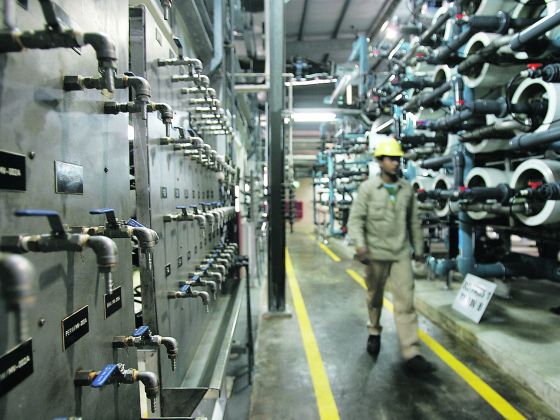
Cecilia Tortajada and Sunil Nambiar
TODAY | August 19, 2017
Today, 2.1 billion people lack access to drinking water. By 2050, 3.9 billion people — more than two in five people — will live under severe water stress. Many reservoirs around the world are drying up, and countries around the world are struggling to produce water to keep pace with demand.
The truth is that while water is not an infinite resource, it can be used over and over again. There is more than enough water for every one of us around the world. The issue at hand is, however, that policy makers around the world are repeating the same mistakes when it comes to managing water supply. Wastage and pollution are rampant, and conserving water sources to keep up with rising demand is still an afterthought.
SINGAPORE’S CIRCULAR WATER APPROACH
While the natural water cycle is circular, policy makers around the world too often opt for a linear approach. This fails to take into account water’s inherent recyclability.
Singapore, which marked 52 years of independence this month, is one of the very few exceptions. And the city-state’s approach to water governance holds lessons for other countries.
The trigger to develop a “circular water approach” was the realisation shortly after independence in 1965 that a sustainable water policy was essential for the nation’s survival. After some years of planning, the 1972 Water Master Plan proposed innovations in terms of policies, management and technology. It considered production of drinking water through desalination and recycling.
This meant linking water management with a circular economy – where used resources are not wasted, but used again. Water, being fully recyclable, is the archetypal circular economy resource. In managing its water supply, the South-east Asian nation was quick to recognise the possibility of reusing and recycling water from hitherto unimaginable sources – its drains and sewers.
RECYCLING WATER FOR HOUSEHOLD AND INDUSTRIAL USE
Ultrapure recycled water in Singapore, branded NEWater, is the exemplar of Singapore’s experience with the circular economy. Introduced in 2002, it is one of the four water sources in the water-scarce nation – the others being water from local catchment, imported water and desalinated water. Recycled water accounts for up to two-fifths of Singapore’s water supply. Because of its cost efficiency, businesses benefit significantly.
Today, a bulk of the NEWater supply is channelled to support the operations of commercial buildings and industries via a piped network. Singapore is the first country to use recycled water to meet higher purity water demands for wafer fabrication. The venture has been highly successful; the world’s top three hard disk drive manufacturers are based in the city-state.
With monitoring and strict control by Singapore’s national water agency at every stage of the production and supply process, NEWater has been a reliable part of the city-state’s drinking water supply for 15 years. In 2014, NEWater was a winner at the United Nations’ (UN) “Water for Life” Best Practices Awards for sustainable management of water resources.
The novel approach to water resource management has not resulted in diminished quality. NEWater well surpasses World Health Organisation and United States Environmental Protection Agency standards, and is cleaner than the water flowing from taps in other major cities. Former UN Secretary-General Ban Ki-Moon once called it the “elixir of life”.
More effectiveness and efficiency are always possible. Policy makers in the nation-state have been investing on research to produce more efficient technologies to reuse and recycle more water with processes that are less energy intensive. This means, not only is used water not wasted and used again, this is done using less energy.
While zero wastage of both clean and used water may be impossible, clearly the less water that is wasted, the better. The most efficient alternative to reach nearly “zero waste” is water conservation by the population and the commercial and industrial sectors. This would effectively mean that millions of litres of water would not have to be produced.
Use of recycled water for potable use is increasing in the world although it has not become a trend yet. Schemes in Windhoek in Namibia, and Orange County and Northern Virginia in the United States have produced it for a longer time than Singapore; while the US state of Texas and city of San Diego, Perth in Australia and Emalahleni in South Africa have developed such capabilities more recently.
MAKING THE CASE FOR RECYCLED WATER
In Singapore, because of NEWater’s unpalatable origins, policymakers are careful not to take public confidence for granted. Even before it was introduced, PUB, the national water agency, took pains to conduct awareness-raising programmes at community centres and workplaces. Information on the water recycling process is included in local science textbooks, and every school organises guided tours to the NEWater Visitor Centre for students to witness the process first-hand.
Education alone, however, is not enough to foster public acceptance. Establishing trust in the national water agency’s capability to continuously produce clean water has been crucial. Drinking NEWater in public, Singapore’s senior politicians have become de facto ambassadors of recycled water.
Residents have by and large, understood the importance of NEWater as a pillar of the national water supply. An independent Forbes Research poll, conducted at the end of 2002, indicated that NEWater had a 98 per cent public acceptance rate, with 82 per cent of respondents indicating that they would drink NEWater directly and another 16 per cent responding that they would drink it after blending with reservoir water.
Singapore shows that the potential for a circular economy approach to water management exists. Perhaps it is only a matter of time before policy-makers around the world follow suit.
ABOUT THE AUTHORS: Cecilia Tortajada is a senior research fellow at the Institute of Water Policy, Lee Kuan Yew School of Public Policy, National University of Singapore. Sunil Nambiar is a researcher at the same institute.
Source: http://bit.ly/2vOEWUi